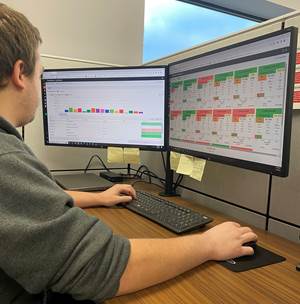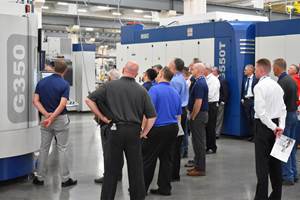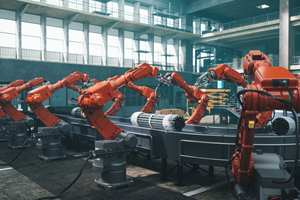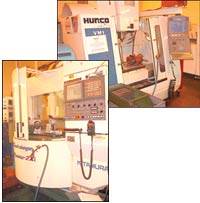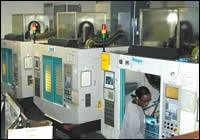Why Boeing Is Big On Right-Size Machine Tools
Simple, dedicated machines save on capital expense, while they also make it possible to realize one-piece flow. These machines are often developed internally. 'Chaku-chaku' is the new ideal.
Here is one way to machine a part: Just set it up on a machine tool and go. A machine tool capable of multiple functions or multiple orientations may be able to perform all of the machining necessary for a part in just one or two setups. If that machine is big, then it can accommodate a wide range of part sizes, from small to large. Simple.
Here is another way to machine a part: Identify every discrete step involved in transforming the raw material into the finished component. Include not only the machining in this analysis, but also any other necessary operation, such as finishing or assembly. Then create a separate, simple machine or workstation for each of these transformational steps, with each station performing just that one step. Arrange these stations in series, having the operator move the part from station to station. Sounds complicated, right?
Look again. That large, complex, versatile machine in the first example actually imposes a variety of costs. They include:
- the cost of the machine;
- the need to schedule time on this machine, because so many different part numbers are visiting it;
- the effort to move the part across the plant to where this immobile machine is located, then to move the part somewhere else after the operations on this machine are done;
- the maintenance costs and potential downtime associated with a complex piece of equipment; and finally,
- the danger of wasted time and material when multiple operations are performed in a single cycle. If an error is produced during the first cut of the cycle, then the rest of that machining cycle is likely to be wasted.
At various Commercial Airplanes plants, particularly in Washington state, engineers with The Boeing Company are now looking at machine tools in precisely this way. They are alert to the danger that large and/or complex machine tools may be inherently wasteful when it comes to producing milled, drilled, cut or stamped parts that can easily be transported by hand. For parts such as these—and some other parts, too—Boeing prefers a “right-size” alternative in which a series of simple machine tools all match the scale and the needs of the particular part. In cases where such a right-size machine tool can’t be purchased, the company builds the machine itself. Plants in the Puget Sound area now have “moonshine shops” devoted to just this purpose. In these shops, teams of creative employees invent and produce machines specifically suited to particular manufacturing needs. Boeing is even teaching its suppliers to think this way, because the company wants the savings associated with right-size equipment to be realized throughout the supply chain.
The extent of those savings can be huge. Mike Herscher leads the Commercial Airplanes group’s Lean Enterprise Office. Douglas Crabb is a consultant with the same office. Together they detail various successes with right-size equipment, including the following:
- Light valences, which are contoured composite parts about 10 feet long that are used on the 777 aircraft, were previously machined on a five-axis router. A ballpark price for the machine is $1 million. Boeing replaced this machine with a one-axis grinder that was engineered in a moonshine shop specifically to perform the material removal required by the valence parts. The cost of this grinder was less than $50,000.
- A landing gear support assembly that used to travel a mile through the plant (literally) had most of its operations consolidated into a cell so that the travel distance was cut by 80 percent. Machining this part used to require a boring mill costing more than $1 million. The work of that machine has been transferred to a tabletop boring unit invented just for that part. This machine costs less than $15,000. Curing the part used to require a large oven, but the oven was replaced by one matching the size of the part at just 1 percent of the big oven’s cost. Because of the smaller size, this internally developed oven also uses less than 1 percent of the electricity.
- A certain small rectangular drilled part, machined from an extrusion, once had to travel to separate locations on the production floor for the sequence of saw-deburr-drill-deburr-saw-deburr. Setup times at each station resulted in a 5-day flow for an order of 50. Today, these operations are all performed on small, dedicated machines within a compact cell that is easily attended by one operator. The same 50-piece order now takes 25 minutes.
The cell in this last example follows the principle of chaku-chaku, which is the ideal that Boeing’s manufacturing personnel now aim to achieve. Derived from the Japanese, the term translates to something like “load-load” or “place-place.” In a chaku-chaku line, setup time has been almost entirely overcome, because the operator merely has to place the part at each dedicated station and hit a button or pull a lever to let that station do its work. The operator moves the part from one simple loading to the next—one dedicated station after another—at an easy pace that does not involve waiting, long travel or hurrying. Having an operator perform this transfer instead of using automation keeps the capital expense and complexity low, while also assuring quality by letting the operator perform simple quality checks as various stations complete their work. When the ideal of chaku-chaku can be realized, the result is a means of low-cost, high-quality, short-leadtime production that can efficiently produce parts in lot sizes of one.
The opposite of chaku-chaku is the production “monument.” This is any big, immobile part of the process that entails setup time or requires the part to travel a long distance to reach it. It could be a big machine tool, or it could be a segregated area of the plant that does specialized work. In many plants, the machine shop itself is a monument. The problem with these monuments is that they force manufacturers to think in terms of batches. The traditional manufacturing process involves batches of parts moving from monument to monument throughout the plant. When Boeing’s process relied more heavily on these monuments, “we were building parts we didn’t need, and that was getting in the way of us building the parts we did need,” Mr. Herscher says.
One shouldn’t be too hard on the monuments, however. Boeing’s process is still full of them, and it will continue to rely on them. For example, big, contoured parts will continue to demand big five-axis machine tools, and some heavy parts with many machining operations simply can’t be machined in any system as efficiently as they can be machined in a palletized cell. Wherever overhead cranes are needed, Mr. Herscher observes, generally monuments are needed, too. Boeing plants are simply questioning these monuments wherever they can. In a surprising number of cases, the monument can be replaced.
Two clues alert production management to cases where this questioning should occur. One clue is a lack of flow. Any point in the process where parts back up and wait offers a hint that a monument may be causing a problem. Another, more decisive clue is an employee’s request for a big check to add or replace a significant piece of equipment. Before approval can be won for a large capital expense, manufacturing personnel are now obliged to analyze whether a much cheaper right-size alternative might do the job instead.
This analysis follows a certain process. In fact, like chaku-chaku itself, the analysis involves a clear sequence of steps.
Getting To Size
When a team of Boeing employees considers whether a component or assembly can be produced in a more streamlined fashion, the first order of business is to determine exactly what work the part requires. That is, what are the transformational steps?
Users of CNC machine tools have not had to think this way in quite a while. A traditional method of machining a part involves importing the model into CAM software and letting the software choose or organize various tools and tool paths. In a right-size approach, however, each distinct cut or feature of the part might represent a different transformational step that should be done at a different station of the cell. If process planners make the mistake of allowing multiple transformational steps to be combined into one right-size machine, then that particular station gains both mechanical complexity and manufacturing complexity, either one of which might erode the benefits that simple, single-function machines can deliver.
Once every transformational step is identified, the Boeing team members are then asked to think of seven different ways to perform each step. Two or three ways might be easy to imagine, but the insistence on seven is meant to expand the mind past individual preconceptions. In pursuit of specifically tailored solutions instead of general-purpose solutions, it can be useful to imagine freely. It can be useful to think like a child. Team members are also encouraged to “look to nature,” seeking ways that the natural world may have conquered similar challenges.
Once the various solutions have been narrowed down into a specific production sequence, the next step is to simulate that sequence—perhaps by building models. This simulation is a part of “try-storming” (as opposed to brainstorming), a step that recognizes that some ideas can only be refined and completed through the attempt to make them real.
This thinking is challenging, and success is not assured. The process does not always produce a streamlined solution. There are times when the big machine has to be replaced with another big machine. More frequently, the “chaku-chaku” ideal can only be realized partly, producing a process that carries single-piece flow just some of the way before it hits an obstacle that demands a reversion to travel or batching.
That’s OK. One of the reasons why these production processes are made to be cheap is that they might be abandoned as the plants get better at streamlining. The seemingly insurmountable obstacles of today are likely to be overcome tomorrow, through some better process that will draw on experience or insights yet to come.
Where Right-Size Fits
Still, there have been many successes already. The thinking outlined above has produced a variety of spots—scattered throughout the plants—where the manufacturing process betrays a visitor’s expectations as to what aircraft part production ought to look like.
Right-size machines, though clean and functional, are nevertheless a long way from seeming “high tech.” In fact, many machines out of the plants’ moonshine shops have been made by salvaging hardware from manual equipment, thus giving a “garage” look to some of the results. This humble simplicity suggests one of three important insights about these machines. Namely:
1. The future may not look futuristic.
We are accustomed to seeing manufacturing technology—like technology in general—get faster and richer in features over time. If this development proceeds faster than the evolution of the users’ needs, then there has to come a point when the most modern equipment offers significantly more capability than its users are able to employ.
Boeing’s right-size processes offer a look at what manufacturing may look like on the other side of this threshold. At Boeing, the manufacturing “technology” now takes the form of a mindset and an approach to planning that is highly alert to hidden inefficiencies and uncharted costs. As a result, the hardware itself follows a sort of anti-technology path in which the equipment shrinks down to the needs of the application.
This leads to a related point:
2. If it’s not necessary, then it’s got to be bad.
That brash-sounding statement is actually a direct quote from Mr. Herscher. He tells the story of a waterjet machine the company ordered for one of its right-size cells. For the price Boeing paid for this machine, the supplier was happy to add certain extra features at no extra charge. By contrast, Boeing’s personnel were less happy when this upgraded machine arrived. They sent it back so it could be stripped down to just the capability specified. The point is this: If you accept the view that added features represent complexity that has to be paid for through maintenance, repair and additional variables added to the process (and this is precisely Boeing’s view), then the extension of this view is that simplicity itself becomes a feature that is worth a premium.
A final fundamental point is this:
3. Knowledge is power.
When evaluating how relevant all of these ideas are outside of Boeing or its supply chain, the knowledge of a particular shop’s mix of parts has to be taken into account. Compared to many other shops, Boeing’s plants enjoy a relatively stable part mix. They know what parts they’ll be responsible for across a fairly long extent of time. A pure job shop that truly doesn’t know what part will come in the door tomorrow is in a different position. Such a shop may be well advised simply to buy the biggest and most flexible standard machine tool it can accommodate. However, if that same shop wins a longer-term contract to supply a particular component to a stable customer, then something like a chaku-chaku line might make sense.
Boeing’s accomplishment is that its manufacturing personnel have leveraged their knowledge of production needs, using this knowledge to pare down their manufacturing equipment and to engineer successful, counter-intuitive manufacturing processes that are often much cheaper than traditional approaches.
So far, most of the successes with this paring down have involved parts with relatively simple cutting and hole-making operations, but these parts were just the low-hanging fruit. Mr. Herscher is confident that right-size processes will eventually be applied to more complex parts as well, including parts currently produced in intricate milling cycles on five-axis machines.
He has wooden models for one such process set up outside his office. In the process that they portray, a part currently run on a $2 million five-axis machine is instead produced using a sequence of three low-cost three-axis machine tools that could be capitalized for a little more than $100,000.
In fact, it’s conceivable that these dedicated, single-function three-axis machines might be cheap indeed. If all that each machine has to do is carry out a particular transformational step, then certain fundamental machining center components can go away.
For example, the same tool is going to remain in place, so why have a toolchanger? That can go. The same workholding is also going to remain in place, so why have a table? That can go, too.
For many within Boeing, this kind of pruning represents the future of the company’s production, offering the kinds of savings that become possible when the process is matched to the part.
Related Content
Machine Monitoring Boosts Aerospace Manufacturer's Utilization
Once it had a bird’s eye view of various data points across its shops, this aerospace manufacturer raised its utilization by 27% in nine months.
Read MoreHow to Meet Aerospace’s Material Challenges and More at IMTS
Succeeding in aerospace manufacturing requires high-performing processes paired with high-performance machine tools. IMTS can help you find both.
Read MoreGrob Systems Inc. to Host Tech Event With Industry Partners
The 5-Axis Live technology event will highlight new machining strategies for optimizing the production of complex medical, aerospace and mold/die parts.
Read MoreIncreasing OEM Visibility to Shopfloor Operations for the Win
A former employee of General Motors and Tesla talks about the issues that led to shutdowns on factory lines, and what small- to medium-sized manufacturers can do today to win business from large OEMs.
Read MoreRead Next
Get Lean, Go Global
A successful manufacturing company must achieve world-class capability within its walls. At the same time, a company has to go after global business opportunities. Hanel Corporation (New Berlin, Wisconsin) is a case in point. It has implemented several U-shaped production cells that help the company keep costs down and productivity up. At the same time, company leaders have aggressively courted customers in countries around the world by offering both tangible and intangible values.
Read MoreVertical Machining Centers For Volume Production
At this model plant for lean manufacturing, Parker Hannifin personnel became convinced that the simple approach was the strongest choice for the application. Part of the lesson learned at this plant is that the most difficult part of going lean may lie in the discussion.
Read MoreThe Post-Machine-Shop Process
Making the transition from batch production to a build-to-order strategy meant removing the kinds of barriers that separated machining from the rest of manufacturing.
Read More

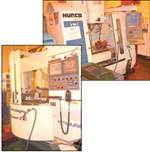


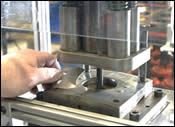
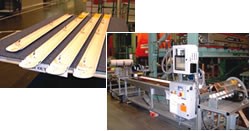
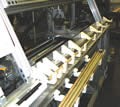
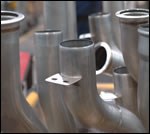
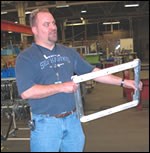
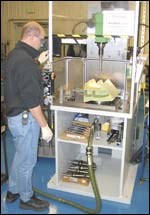
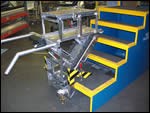







.jpg;maxWidth=300;quality=90)








.jpg;maxWidth=300;quality=90)


